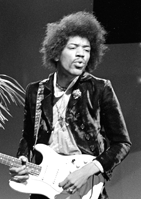Music Through the Years

Labeled for reuse by the Wikimedia Creative Commons
October 14, 2017
Kings have been overthrown, wars have come and gone, and the world has continued to change every day, but the one component of human culture that has remained ever-present is music. To me, music is the purest form of human expression, allowing for every emotion imaginable to be attached to a musical note. Although music has always remained, its ideals, styles, and instrumental uses have evolved immensely. While Bach, Beethoven, and Mozart all have had a massive influence on the evolution of music, I would like to address the changes that have come within the past 60 years, as this music affects our lives daily.
This takes us back to the days of the devil himself: Elvis Presley. His musical and personal styles may not seem very rambunctious when compared to modern day stars, but for his time he was seen as a scandal and a terrible influence. Though this may linger, it is impossible to deny the impact his musicianship had on music to come. His music was revolutionary, with the upbeat tempo and blues-inspired chord progressions that earned him his title of “The King of Rock and Roll.” Fast forward ten years or so into the future, and it is plain to see that the impact of Presley’s music was lasting.
The 60’s – peace, love, and the rise of rock. The electric guitar had been shunned as a incoherent noise machine, but in this decade it would become one of the staples of popular music- and its roots stem from the blues. Old players like Robert Johnson, Howlin’ Wolf, Muddy Waters, and Elmore James would inspire a rising class of guitars including Eric Clapton, Jimmy Page, and Jeff Beck to turn up the volume and rock out.
“They heard the sweet tones on the guitar and other instruments, and used that soul in their own music,” said Air Academy student Jacob Martino.
Jimi Hendrix, regarded by most as the greatest guitarist of all time, would be the pioneer of psychedelic rock, pulling from his blues roots to create sounds never heard before. Bands like Cream, Led Zeppelin, The Beatles, and The Jimi Hendrix Experience would become the staple names of rock music.
“Well, the 50’s scene was very strict, so I think that the generation that grew up in the 60’s was rebelling against their parent’s views,” said Maddie McCluskey, an avid rock and roll listener and appreciator.
The 70’s would see much of the same rock power from the 60’s, as Led Zeppelin exploded to become one of the most successful bands of all time, and the American group “The Eagles” would find a large amount of success riding their country-infused rock to the top of the charts. But another style of music going by the name of Disco would become popular among the young people of the world. The funky, bass popping melodies of disco would be trail blazed by the Beegees, Earth, Wind, and Fire, and Kool and the Gang.
“Disco music is cool because it is funky and you can dance to it, but in some ways it took over and pushed out the classic rock of 70’s, which in my opinion is better than disco” explained Martino. Disco would go on to influence genres like pop, rap, and hip-hop music through the 80’s and 90’s.
“I like disco artists like Abba, but back in those days the disco scene was a lot like the pop scene of today, and I don’t normally like to listen to pop because it is overplayed. I feel like that is what happened to disco back in the day, but I still like disco and love dancing to it,” described McCluskey.
Next, the 80’s. The 80’s were a time when music became heavily influenced by technology, as seen in the pop music of the decade. Artists like Madonna saw massive success out of this 80’s pop style, yet the presence of rock was still heavily felt with artists including Van Halen and Stevie Ray Vaughn. Rap saw its first glimpses of success, as The Sugarhill Gang’s “Rapper’s Delight” paved the way for groups like N.W.A. to take a stand in the later part of the decade. Metal was a massive part of the end of the 80’s, as bands like Metallica and Megadeath attracted massive followings with their hairsplitting, hard rocking sounds. But as the 80’s came to a close, the commercial hits took a backseat to the underground scene.
The Seattle sound was catapulted into the mainstream in the 90’s as bands like Nirvana, Pearl Jam, and Alice in Chains revealed their uneasiness towards society and the world as a whole. Oasis and Blur made names for the rising alternative scenes. Even still, the commercial remained in a portion of the limelight, with the rise of Boy bands like NSYNC and the Backstreet Boys. Overall, the nineties can be defined as a melting pot for musical trial and ideas.
With the turn of the century came a new outlook on music. The early portions of the 2000’s saw a rise in hip-hop music, defined by its hard hitting base and somewhat taboo ideals. Now, music has seemed to be defined by the technology the artist has access too, and the sound has become electronically based in the popular music of today. Rap has become the dominant music genre of America for the first time in history, and though the music grabs attention, it may reveal ideals not suited for the youth of the country.
“Some people identify with the lyrics that rappers say, and connect with the toughness,” explained Martino.
I apologize for missing a large majority of the music in the last half century, but the bottom line is that music has changed with the age and the times, either for the better or the worse. That’s the special part of music, it is up for your own interpretations. You can like whatever music you connect with, and the possibilities are endless.






Kennedy • Oct 19, 2017 at 11:21 am
Very informative Calvin, Rock On!